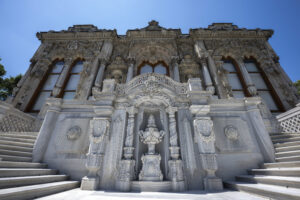Ottoman engineering is renowned for its architectural brilliance; moreover, Turkish marble was a key material that contributed to the grandeur of its historic structures. Turkish marble is a luxurious material known for its unique designs; consequently, it greatly enhances the beauty and grandeur of Ottoman architecture. Therefore, this article explores Turkish marble’s role in Ottoman construction, highlighting its impact on architecture and visual arts of the era.

Engineering in Service of Art and Architecture:
- Art and ornamentation: Marble was widely used in ornamentation and carvings on the facades of mosques and palaces, thereby symbolizing luxury and artistic beauty.
- Religious Architecture: Marble played a prominent role in mosque construction, used to embellish key areas such as mihrabs, domes,and minarets
Engineering in Mosque and Palace Construction:.
- Advanced engineering techniques were carefully used to create complex geometric domes and arches; as a result, they significantly add a unique and impressive artistic character to mosques and palaces.
- Structural Engineering: Innovative techniques using arches and domes provided exceptional support for large mosques and palaces.
Materials and Techniques:
-
Ottoman mosques and palaces used diverse marbles; for instance, Marmara Island marble is famed for its lasting luxury and elegance.
- Carvings and Decorative Artifacts: Marble carving and engraving techniques were employed to add intricate decorative details to facades and columns.

Manifestations of Engineering in Ottoman Architecture:
- Harmonious Engineering: A splendid engineering balance was achieved between artistic beauty and practical engineering functions, embodying innovation in Ottoman architecture.
Innovation in Design: Geometric marble designs add mosques and palaces a unique, elegant, and artistic touch to their architectural style.
In conclusion:
The convergence of art and engineering in the world of Turkish marble manufacturing creates a unique experience. It blends tradition and technology, uniting artistic beauty with engineering precision to bridge heritage and the future.
Turkey’s marble: industry and engineering reflect Ottoman Empire’s rich history and civilization, creating masterpieces blending tradition and innovation.


